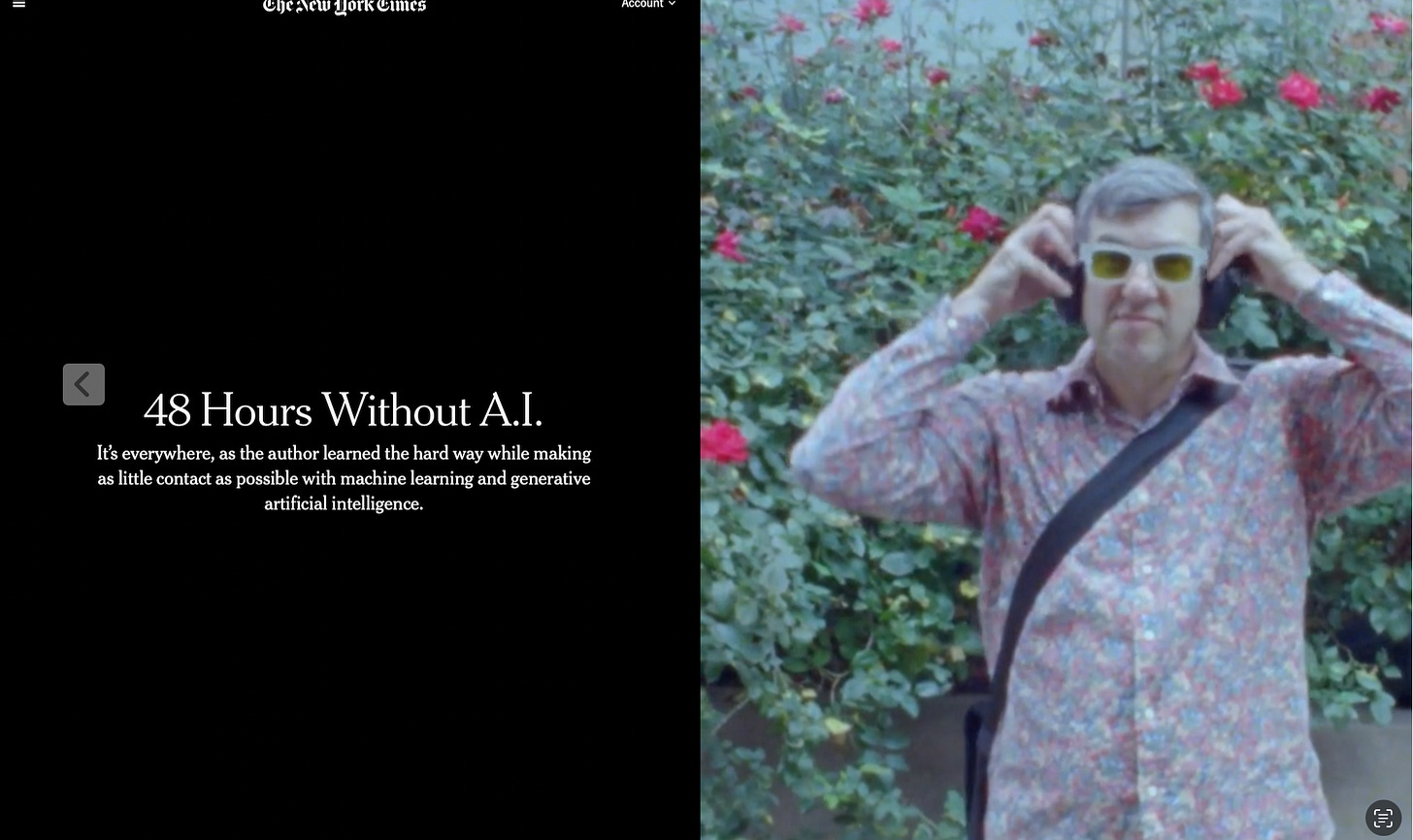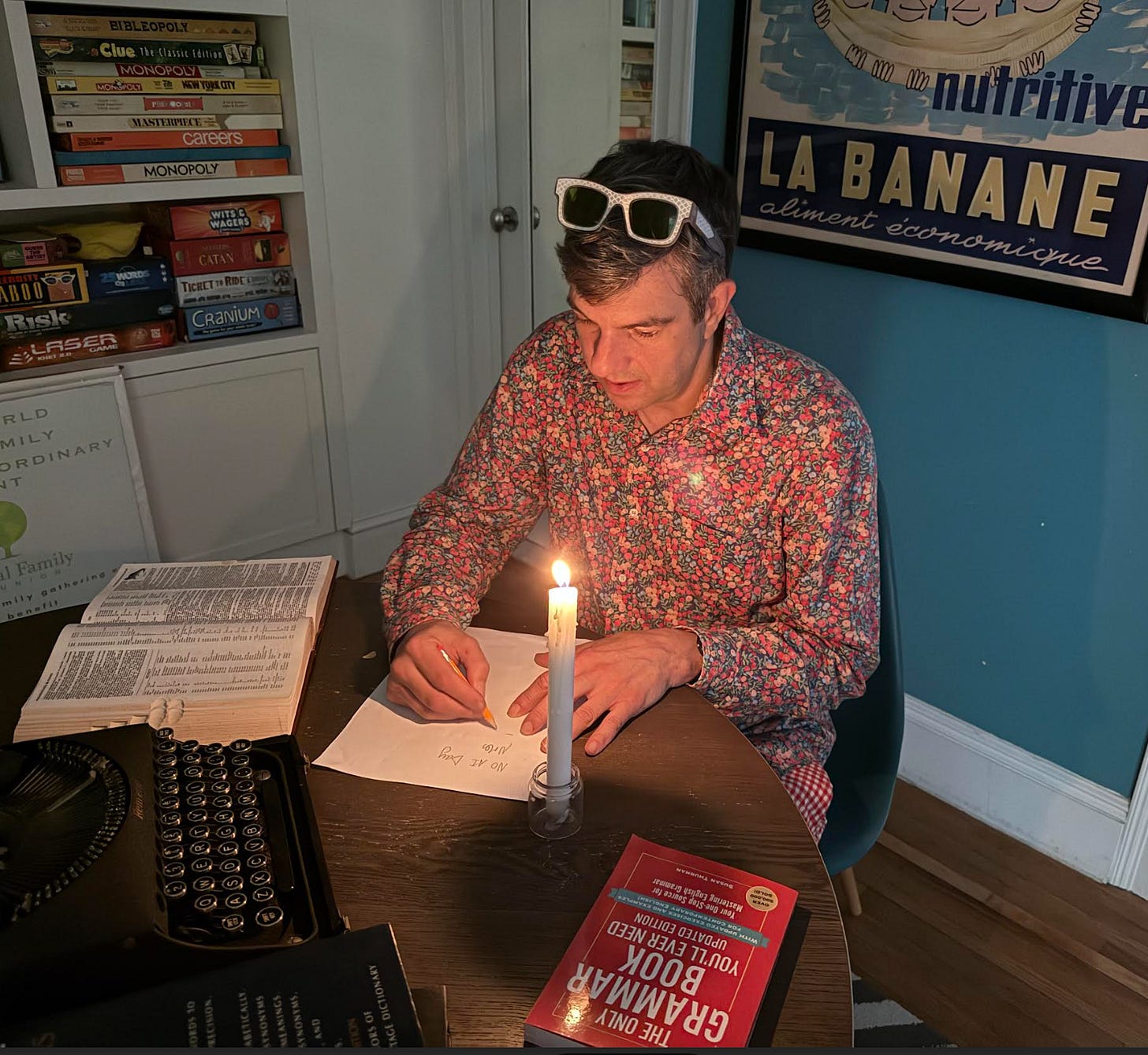My Big A.I. Experiment: Behind-the-scenes and Takeaways
This post was written without the help of A.I.
Well, sort of. I can assure you that I did not ask ChatGPT to crank out an outline, suggest headlines, or provide images.
But A.I. still seeped into the process of writing this post in a hundred ways. For starters, my Apple laptop uses A.I. and machine learning for spellcheck and battery conservation, among other things.
My office chair – like everything else in the supply chain – was shipped and trucked along A.I.-optimized routes. My electricity is brought to me in part by A.I. -- Con Edison uses A.I. to spot voltage problems and schedule repairs.
And on and on.
So to be more precise: This post was written with some help from A.I. and machine learning, as has every Substack post I’ve ever published.
I’ve been thinking a lot about A.I. because The New York Times assigned me an article with the following premise: Spend 48 hours attempting to avoid interacting with any A.I. or machine learning.
The article was published online a couple of days ago. Check it out if you have a moment. I also thought I’d give my Substackers some behind-the-scenes details:
The piece was a semi-sequel to an article I wrote for the Times two years ago in which I tried to avoid touching anything containing plastic for 24 hours. Which turned out to be insanely hard, because plastic is everywhere: In our clothes, in our carpets, our food.
A few weeks ago, my editor, the great Jim Windolf, thought it would be good to try a similar experiment with A.I. instead of plastic, and to go 48 hours instead of 24, perhaps because I didn’t suffer enough the first time.
The experience turned out to be bizarre, fascinating, absurd, and unsettling.
As I say in the article, I first had to define A.I. Most of the experts I spoke with said that A.I. is a big umbrella. It covers Generative A.I. (such as ChatGPT and Claude), which gets most of the publicity. But the term A.I. also covers machine learning, which has been around for decades. Machine learning programs evolve themselves and their predictions based on new data.
Think of traditional software as a static recipe: Input A yields output B. Machine learning software is more like a recipe that changes ingredients according to the feedback it gets. If it notices people are buying more sweet things, it adds sugar to the recipe. When my Waze app updates with a new route to my son’s college, I can thank machine learning. The computer has picked up patterns in the data and adjusts accordingly.
Almost all forms of A.I. have this in common: They have the ability to learn and evolve – which means lots of unpredictable consequences, sometimes good ones and sometimes bad ones.
So what was it like to live for two days with no A.I.? As you know, I like to commit to the bit. So that meant some radical changes, including:
(Photo by Julie Jacobs!)
--My clothes: Many clothing retailers use A.I. for design ideas and marketing, and almost all clothes are shipped along A.I.-optimized routes. So to be safe, I avoided modern clothes. Deep in my closet, I found some clothes my grandfather had given me: A pair of red-and-white checkered pants that looked like an Italian restaurant tablecloth, and a brightly colored, flowered shirt. My grandfather was quite the dandy. I was initially embarrassed (my usual clothes are boring and dark), but Julie told me it was the coolest I’d looked since our wedding, which was both flattering and insulting.
--My food and drink: The New York Reservoir system uses a machine learning tool to help anticipate demand and figure out when repairs are needed. The scientists and engineers make the final decisions, but they use machine learning to help. So to be safe: No tapwater. I had collected a bunch of rainwater in bowls on my window sill in the weeks preceding the experiment. I also avoided grocery food, and did some foraging in Central Park. Apparently, plantain weeds are not poisonous, but they don’t taste so hot either.
--Entertainment: No iPhone or laptop, of course. And no paying attention to Netflix recommendations, which are A.I.-powered. Instead, I got a recommendation from my high school English teacher, a film buff. I watched the 1970 Robert Altman movie Brewster McCloud on a DVD from two decades ago, plugged into a solar generator.
At times, I felt like I was doing Amish cosplay. Or maybe re-enacting Little House on the Prairie.
Like many of my experiments, it was partly absurd and partly thought-provoking. It made me grapple with A.I. – and whether this technology will be good for humanity or bad for humanity.
My prediction: Both.
A.I. is a tool, and like every other tool, it can be used to benefit us or harm us. (A hammer can be used to build an orphanage, or smash a child’s favorite doll).
A.I. has already done wonderful things for the world. I’m grateful to the Waze traffic app for saving me hours of frustration and wasted time. I’m grateful Generative A.I. is coming up with new medicines for all sorts of diseases.
But A.I. has already wreaked a lot of havoc as well. The misinformation and disinformation crisis owes a lot to A.I. YouTube’s machine learning-fueled recommendations have radicalized millions of people by suggesting ever more extreme videos. You’re interested in covert CIA ops? Here are three videos on how 9/11 was an inside job!
My question is: In ten years, which will be more salient – the positive or negative consequences? Will the world overall be better or worse in ten years when A.I. is even more entrenched?
I think it’s partly up to us N.I. folks (Natural Intelligence). We have to figure out how to guide, regulate, and monitor A.I., and make sure its goals align with ours.
How to accomplish this? I’d love to hear ideas from you all. But my A.I. experiment did inspire a few suggestions.
1) Give A.I. some tough love. (And tell it to give us some tough love).
I found it really important to tell ChatGPT to stop being a kiss-ass.
As I discuss in the Times article, I didn’t use ChatGPT during my 48 hours of no A.I.- but in the weeks leading up to my experiment, I did use ChatGPT to help me research. I know! Ironic. Self-contradictory even!
ChatGPT can be an incredibly powerful research tool—it found many relevant studies and statistics for my piece.
But of course, it’s also a dangerous research tool, because it’s only partly accurate. One big problem is that it’s a Confirmation-Bias-O-Matic. My ChatGPT inferred the thesis of my article – that A.I. is everywhere -- and started fudging its answers in that direction. It’s a people pleaser. So it fed me solid data, but also speculation and half-truths that I had to rigorously fact-check.
One helpful strategy was to give my ChatGPT some tough love. I had to insist it only use the most reliable of sources and find concurring sources as well. I also found it useful to pretend I was looking for the opposite of what I was really looking for. I would give my ChatGPT prompts such as:
“I’ve heard that the car business uses a lot of A.I. in design. But is that really true? Can you look to reliable sources and see if there is anything to back up this claim, or is it merely exaggeration and wishful thinking?”
This would make ChatGPT look for counterexamples that might negate my premise.
2) More transparency, please.
I think it’s important that anything that’s the result of A.I. and machine learning is clearly labelled as such.
This is especially crucial in photos and videos, so we can identify deepfakes, which are getting alarmingly good. I’m in favor of the proposed legislation in California requiring A.I. platforms to watermark fake images.
But I want warnings on text too. For starters, I feel emailers should be more honest about what they wrote and what was spat out by a robot. Maybe emails should have an auto-generated tag that says “written 40 percent by ChatGPT” (or 30 or 80 percent).
3) More control over the algorithms that influence my life, please
I hate that I have so little control over these algorithms. Consider my Facebook feed. It drives me crazy that Mark Zuckerberg’s A.I. program has so much sway over my information diet. I want my information diet to be balanced and nutritious, because it influences my beliefs and actions. Facebook’s A.I. wants my information diet to be whatever keeps me on Facebook (often stuff that provokes outrage).
I want to be able to give Facebook instructions. “Show me more posts from people I disagree with. Show me more posts from people who live in rural areas. Don’t just show me what will reinforce my beliefs. Also, stop showing me any photos of appetizers. That really doesn’t interest me.”
Maybe Facebook does have some ways to control your feed better, but they don’t make it easy. I want there to be a bunch of dials right on the opening page that will let me tinker with my information diet.
How else can we try to make sure A.I. is mostly good, and not the end of civilization? Let me know your (or your avatars) thoughts.
PART 2: The PUZZLER UPDATE!!!
As many of you know, one of my other gigs is hosting The Puzzler podcast. Well, we’re starting Season 3 on November 10, and we’ve got some fun changes ahead.
What changes exactly? Here’s a summary – which was NOT written by ChatGPT, but it was written by our wonderful producers Adam Neuhaus and Neely Lohmann.
Big News from The Puzzler
After two incredible years and 500+ episodes of The Puzzler, we’re evolving into something even better: Hello Puzzlers - a true puzzle community where you’re not just listeners, but active participants.
Here’s what’s changing and what it means for you:
• The Puzzler is going fully independent - joining the creator economy and becoming a sustainable, community-funded show
• Season 3 launches with video - watch us solve puzzles on YouTube alongside the audio podcast
• A “Hello Puzzlers” community on Patreon - join for exclusive content, bonus puzzles, and direct interaction with me and Greg
We’re building this because you told us you wanted more - more puzzles, more behind-the-scenes content, and more ways to connect with fellow puzzle lovers. The free podcast isn’t going anywhere, but for those who want to dive deeper, Hello Puzzlers offers a home for true puzzle enthusiasts.
Join the “Hello Puzzlers” community on Patreon → here’s the link.
Whether you join as a member or continue as a free listener, thank you for being part of this journey. Your love for puzzles is what makes this show possible.






Hey, great read as always. You really illustrate how ambient intelligence is so integrated now, often without us even realising its working in the background. So insightful.
What happened to your quill?